30 May Alaska Fishing Report: May 30, 2013
The 2013 fishing season is officially underway although in many respects it seems several weeks late. We experienced a very cold and reluctant spring with early and mid May temperatures still dipping well below the freezing mark in the morning and barely eclipsing 50 degrees during the day. This did little to encourage king salmon in the salt water to enter the rivers as to them this is still more characteristic of late winter than the beginning of summer. Fast forward to the last week to ten days and suddenly we are seeing one of the finest warm weather streaks I can remember in several seasons with highs now soaring up to seventy plus degrees. Indeed Alaska weather is like riding a roller coaster, you just never know what to expect. Needless to say, going from below freezing temps to mid sixties and seventies has caused river levels to rise dramatically and on the Kenai, it has resulted in very poor water conditions as excessive snow melt from the tributaries is turning the river into a murky mess and not the turquoise green so many associate with the Kenai River. Fishing on the Kenai has been slow at best with only a small handful of king salmon being taken so far. Several weeks ago, citing low forecast numbers, ADF&G issued an emergency order making all Kenai King salmon catch and release only. This was done to ensure as many kings as possible are able to spawn this season as with recent years of low abundance, these fish have just not been making the needed escapements to foster healthy runs in the future. This season’s return is looking much like it did last year, too low to allow harvest. Only time will tell what the remainder of the season will hold but anglers should arrive well prepared for the plan “B” scenario. If the early season numbers thus far are any indication of run strength, slow fishing and possibly even additional restrictions such as a full closure, are a definite reality. On the Kasilof River, emergency orders were also issued banning all retention of naturally produced king salmon and reducing the bag limit to one hatchery fish. This fishery remains a mere shadow of its former self as hatchery planting has been at historically low levels in the past 5-8 years as ADF&G has struggled with a myriad of hatchery production issues including a lack of funding, infrastructure problems at the hatcheries themselves, culvert woes in Crooked Creek and number of other systemic tribulations. Due the low run of naturally occurring Crooked Creek king salmon last season the Department failed to receive enough fish to obtain a hatchery egg take and therefore no hatchery fish were released into the system this spring. This does not bode well for the parent return four and five years from now and explains why they have enacted the restrictions to begin this season. Hopefully by not allowing any retention of naturally occurring king salmon on the Kasilof, they will get enough fish back to meet their required escapement and use the excess fish as brood stock to return hatchery numbers to their former glory. They have constructed a new state of the art multimillion dollar hatchery to raise the fish in Anchorage and funding has been set aside in the state budget to fix infrastructure and culvert issues. This is all good news and represents definite steps in the right direction but those familiar with the wheels of government and the life cycles of salmon know these changes will not improve things overnight.
Meanwhile in three trips so far on the Kasilof, we have only caught one natural adult king, seven jack salmon, one sockeye, a few downriver steelhead and several sea-run dolly varden. With water temperatures far colder than normal and an abundance of moss and debris in the water, conditions for fish entering the river has not been ideal. We are sure to see things pick up as we get close the historical peak for this run in first two weeks of June but indications so far point to another less than average return for king salmon on the Kasilof.
The one shining star so far this season has been the marine fishery in Cook Inlet. Halibut catches have been outstanding and the fish have been clearly fat and healthy with an abundance of crab, shrimp and other bait fish in their stomachs. This is a clear difference from last season when many of the fish seemed mal-nourished and stressed. King salmon fishing in the troll fishery off Ninilchik and Anchor Point has also been quite good so far with a number of boats reporting good catches daily. Most of these fish are feeder kings that will not be retuning to spawn in our area rivers this season but nonetheless their presence and relative abundance does provide a positive glimpse into future returns.




